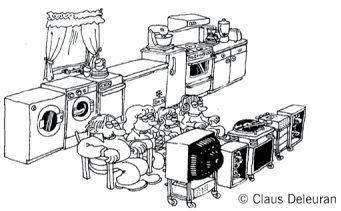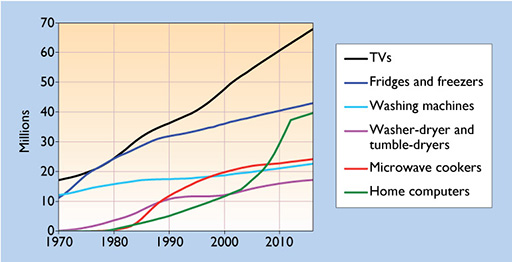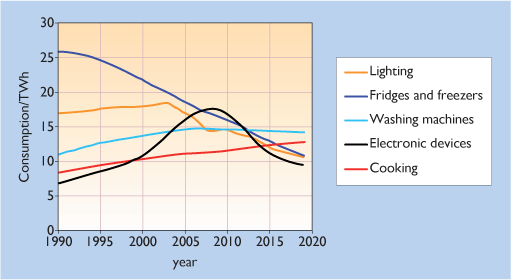4 Saving electricity
In 2019, the UK domestic and services sectors each used roughly 100 TWh of electricity, making up nearly 60% of the total national electricity consumption of 325 TWh. Nearly all of this was electricity was used for non-heating purposes (BEIS, 2021c).
Cutting electrical demand in buildings requires tackling a whole range of uses including the lifestyle changes that increased electricity use has brought to our society.
Mains electricity started as a lighting technology, but then rapidly diversified into motive power and then a host of electrical appliances. Many ‘labour-saving’ devices like vacuum cleaners and washing machines were introduced in the 1920s and 1930s to cope with a ‘servant shortage’ after World War I. Refrigerators and freezers have allowed shopping to be done once a week rather than daily and allowed the storage of pre-packaged convenience foods.
In parallel there has been a growth of ‘electronic entertainment’, for example radio, television, hi-fi, and the computers and internet for fun rather than work (see Energy Saving Trust, 2006, Rise of the Machines [Tip: hold Ctrl and click a link to open it in a new tab. (Hide tip)] . This is a ‘technology snapshot’ from 2006 and you may like to reflect on how things have changed since then).
It raises questions of what exactly is the modern ‘good life’? Is it just one of owning lots of appliances to make our life easier so that we can slump in a chair and be entertained by the latest electronic gadgets (Figure 37)?
Figure 38 shows the growth in UK ownership of some of these appliances since 1970. Given that the number of UK households grew from 19 million in 1970 to nearly 28 million in 2016, the average 2016 household would appear to have owned 1.4 home computers and 2.4 televisions.
Looking to the future, the UK population is likely to increase from its 2017 value of 67 million. The average household size is also falling. In 2010, it was about 2.3 persons per household, but this is likely to fall to 2.1 persons by 2050. The total number of households could thus rise to well over 32 million by 2050 (Boardman et al., 2005). Into every extra household goes another set of appliances.
In 2019 electricity use by domestic cooking, appliances and lighting amounted to nearly a third of national electricity demand. Figure 39 shows the trends in consumption since 1970 for different categories. Although programmes of promoting energy efficient fridges and lighting have had an effect since 1990, the gains have been offset by the growth in consumption of a host of electronic devices: TV’s, mobile phones, home computers, etc. The energy use of these may have been brought under control since 2007 by EU standards for the maximum energy consumption of small appliances.



